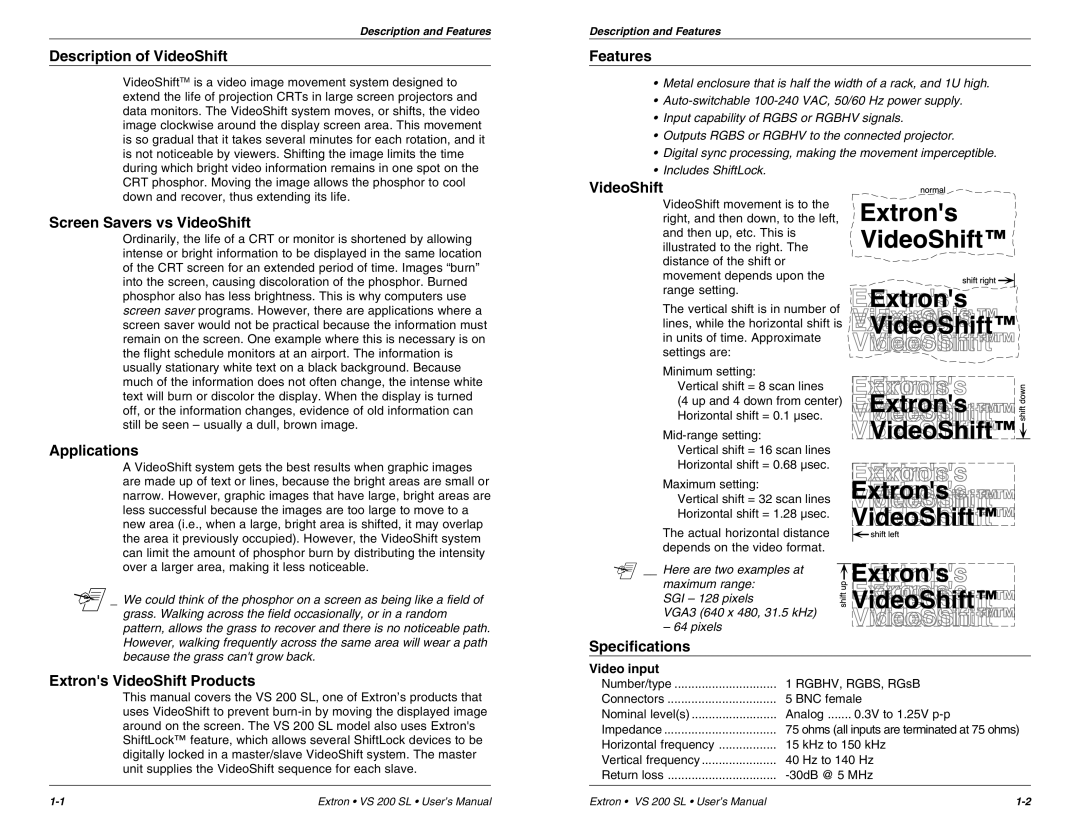
Description and Features
Description of VideoShift
VideoShiftTM is a video image movement system designed to extend the life of projection CRTs in large screen projectors and data monitors. The VideoShift system moves, or shifts, the video image clockwise around the display screen area. This movement is so gradual that it takes several minutes for each rotation, and it is not noticeable by viewers. Shifting the image limits the time during which bright video information remains in one spot on the CRT phosphor. Moving the image allows the phosphor to cool down and recover, thus extending its life.
Screen Savers vs VideoShift
Ordinarily, the life of a CRT or monitor is shortened by allowing intense or bright information to be displayed in the same location of the CRT screen for an extended period of time. Images “burn” into the screen, causing discoloration of the phosphor. Burned phosphor also has less brightness. This is why computers use screen saver programs. However, there are applications where a screen saver would not be practical because the information must remain on the screen. One example where this is necessary is on the flight schedule monitors at an airport. The information is usually stationary white text on a black background. Because much of the information does not often change, the intense white text will burn or discolor the display. When the display is turned off, or the information changes, evidence of old information can still be seen – usually a dull, brown image.
Applications
A VideoShift system gets the best results when graphic images are made up of text or lines, because the bright areas are small or narrow. However, graphic images that have large, bright areas are less successful because the images are too large to move to a new area (i.e., when a large, bright area is shifted, it may overlap the area it previously occupied). However, the VideoShift system can limit the amount of phosphor burn by distributing the intensity over a larger area, making it less noticeable.
_ We could think of the phosphor on a screen as being like a field of grass. Walking across the field occasionally, or in a random pattern, allows the grass to recover and there is no noticeable path. However, walking frequently across the same area will wear a path because the grass can't grow back.
Extron's VideoShift Products
This manual covers the VS 200 SL, one of Extron’s products that uses VideoShift to prevent
Description and Features
Features
•Metal enclosure that is half the width of a rack, and 1U high.
•
•Input capability of RGBS or RGBHV signals.
•Outputs RGBS or RGBHV to the connected projector.
•Digital sync processing, making the movement imperceptible.
•Includes ShiftLock.
VideoShift
VideoShift movement is to the right, and then down, to the left, and then up, etc. This is illustrated to the right. The distance of the shift or movement depends upon the range setting.
The vertical shift is in number of lines, while the horizontal shift is in units of time. Approximate settings are:
Minimum setting:
Vertical shift = 8 scan lines
(4 up and 4 down from center) Horizontal shift = 0.1 µsec.
Vertical shift = 16 scan lines
Horizontal shift = 0.68 µsec.
Maximum setting:
Vertical shift = 32 scan lines
Horizontal shift = 1.28 µsec.
The actual horizontal distance depends on the video format.
__ Here are two examples at maximum range:
SGI – 128 pixels
VGA3 (640 x 480, 31.5 kHz)
–64 pixels
Specifications
Video input
Number/type | 1 RGBHV, RGBS, RGsB | |
Connectors | 5 BNC female | |
Nominal level(s) | Analog | 0.3V to 1.25V |
Impedance | 75 ohms (all inputs are terminated at 75 ohms) | |
Horizontal frequency | 15 kHz to 150 kHz | |
Vertical frequency | 40 Hz to 140 Hz | |
Return loss | ||
|
|
|
Extron • VS 200 SL • User’s Manual | Extron • VS 200 SL • User’s Manual |
